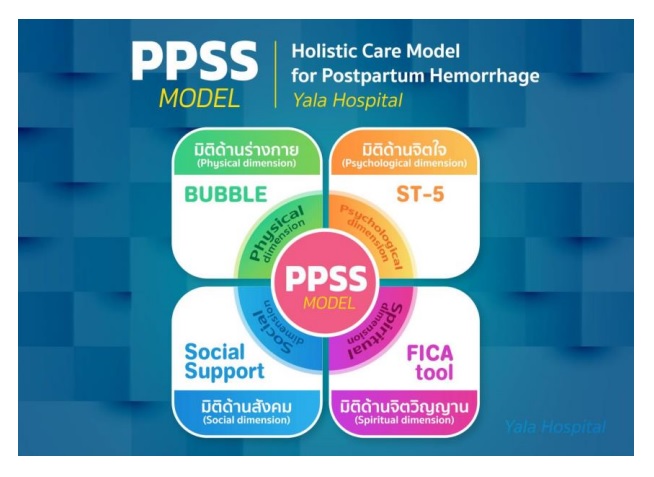Mothers with Postpartum Hemorrhage: A New Holistic Care Model from Obstetrics and Gynecology Ward of Yala Hospital
Keywords:
Holistic Care, Postpartum Hemorrhage, Obstetrics and Gynecology, Yala ProvincAbstract
This research and development aimed to: 1) study the holistic care of postpartum hemorrhage mothers, 2) establish a holistic postpartum hemorrhage care model; and 3) assess the appropriateness and feasibility of applying such new postpartum hemorrhage care model at the Obstetrics and Gynecology ward of Yala Hospital. The research was divided in 3 steps. First step was to study the holistic care of postpartum hemorrhage mothers by reviewing the postpartum hemorrhage prevalence and the current situation regarding the postnatal care of mothers. The sample was 12 professional nurses in Obstetrics and Gynecology ward at Yala Hospital. The tool used was an open-ended questionnaire. Its content validity was checked by 3 experts, obtaining a CVI between 0.67-1.00. Data were analyzed by descriptive statistics. Second step was the process of creating a new model by using the data obtained from step 1. Third step was the feasibility assessment step of the model by 8 experts. The tool used was a questionnaire on the suitability and feasibility of the model. Content validity was checked by 3 experts by determining the content validity index, getting a value between 0.67-1.00. It was analyzed by descriptive statistics such as percentage and mean. The results showed the following.
1. Guidelines for the prevention of holistic postpartum hemorrhage after 2 hours postpartum found that 75% of the guideline was not comprehensive. Almost 60 percent (58.33%) of the guideline use could prevent postpartum hemorrhage. The percentage of care to prevent postpartum hemorrhage in terms of physical dimension (P), psychological dimension (P), psychosocial dimension (P), and spiritual dimension (S) were 100, 100, 58.33, and 91.67, respectively.
2. The holistic care model for mothers with postpartum hemorrhage at Obstetrics and Gynecology ward, Yala Hospital is the PPPS Model.
3. The PPPS Model was appropriate and feasible to use at the high level.
The organization can use the PPPS Model as a guideline for designing a maternal postpartum hemorrhagic assessment for comprehensive and holistic care. It can be used as a standard care of the hospital to achieve the highest efficient care for mothers with postpartum hemorrhage.
References
Borneman, T., Ferrell, B. & Puchalski, C. M. (2010). Evaluation of the FICA Tool for Spiritual Assessment. Journal Pain Symptom Manage, 40(2), 163-173.
Bua Son, R. (2022). Research and Development of Educational Innovations. (6th ed). Chulalongkorn University Press. Bangkok. (in Thai).
Carroll, M., Daly, D. & Begley, C. M. (2016). The Prevalence of Women’s Emotional and Physical Health Problems Following a Postpartum Haemorrhage: a Systematic Review. BMC Pregnancy and Childbirth, 16(1), 1-11.
Department of Mental Health, Ministry of Public Health. (2015). Guidelines for Using Mental Health Tools for for Public Health Personnel in Community Hospitals (Chronic Disease Clinic). Agricultural Cooperative Society of Thailand Co., Ltd. Printing House. (in Thai).
House, J. S. (1981). Work Stress and Social Support. Reading, MA: Addison-Wesley. Jasemi M, Valizadeh L, Zamanzadeh V, & Keogh B. (2017). A Concept Analysis of Holistic Care by Hybrid Model. Indian J Palliat Care, 23(1), 71-80.
Keeves, P. J. (1988). Educational Research, Methodology and Measurement: An International Handbook. Oxford: Pergamon Press.
Khaemmanee, T. (2013). Teaching Style A Variety of Choices. (8th ed). Bangkok: Chulalongkorn University.
Maneechan, N. & Jamnam, U. (2017). Effectiveness of Implementing Clinical Nursing Practice Guidelines for Prevention of Early Postpartum Hemorrhage at Ratchaburi Hospital. Regional Medical Journal 11, 31(1), 143-155. (In Thai).
Murray, S. S. & McKinney, E. S. (2014). Pain Management During Childbirth in Foundation of Maternal-Newborn and Women’s Health Nursing. (6th ed). United States of America: Saunders Elsevier.
Panyawong, K. & Pruksunan, P. (2012). Documentation for Learning about Health Care Holistic. Faculty of Arts Community Health Management Program Learning Institute for All. (In Thai).
Pillitteri, A. (2014). Maternal & Child Health Nursing, Care of the Child Bearing & Childrearing Family. (7th ed). Lippincott: Williams, & Wilkins, p.1289.
Queensland Maternity and Neonatal Clinical Guidelines Program. (2012). Primary Postpartum Hemorrhage. Queensland Maternity and Neonatal Clinical Guideline. Retrieved July 20, 2022 from www.health.qld.gov.au/qcg.
Siriphan, S. (2014). Nursing Mothers After Childbirth with Cultural Differences. Narathiwat: Narathiwat Printing House. (in Thai).
Soowit, B., Panasakulkan, S., Pongsathonviboon, K. & Lhaosupab, N. (2018). Effects of Using Learning Model for Promoting the Holistic Palliative careamong Nursing Students, Kuakarun Faculty of Nursing, Navamindradhiraj University. Journal of The Royal Thai Army Nurses, 19(1), 210-220.
Soowit, B., Panasakulkan, S., Pongsathonviboon, K. & Lhaosupab, N. (2018). Effects of Using Learning Model for Promoting the Holistic Palliative Careamong Nursing Students, Kuakarun Faculty of Nursing, Navamindradhiraj University. Journal of The Royal Thai Army Nurses, 19(1), 210-220.
The Royal Thai College of Obstetricians and Gynecologists. (2015). Guidelines for Medical Practice of the Royal College of Obstetricians and Gynecologists: Care and Treatment of Postpartum Hemorrhage Constrict. Retrieved July 12, 2022, From http://inspection.anamai.moph.go.th/uploads/docs/g1/ (in Thai).
Tort, J., Rozenberg, P., Traoré, M., Fournier, P. & Dumont, A. (2015). Factors Associated with Postpartum Hemorrhage Maternal Death in Referral Hospitals in Senegal and Mali: Across Sectional Epidemiological Survey. BMC Pregnancy and Childbirth, 15(235), 1-9.
Ventegodt, S., Kandel, I., Ervin, D. & Merrick, J. (2016). Concepts of Holistic Care. Retrieved July 10, 2022, from: 10.1007/978-3-319-18096-0_148.
World Health Organization (WHO). (2012). WHO Recommendations for the Prevention and Treatment of Postpartum Hemorrhage. Geneva: WHO. Retrieved July 10, 2022, from http://www.who.int/iris/bitstream/10665/75411/1/9789241548502_eng.pdf WHO

Downloads
Published
Issue
Section
License
Copyright (c) 2022 The Southern College Network Journal of Nursing and Public Health

This work is licensed under a Creative Commons Attribution-NonCommercial-NoDerivatives 4.0 International License.
1. บทความหรือข้อคิดเห็นใด ๆ ที่ปรากฏในวารสารเครือข่าย วิทยาลัยพยาบาลและการสาธารณสุขภาคใต้ ที่เป็นวรรณกรรมของผู้เขียน บรรณาธิการหรือเครือข่ายวิทยาลัยพยาบาลและวิทยาลัยการสาธารณสุขภาคใต้ ไม่จำเป็นต้องเห็นด้วย
2. บทความที่ได้รับการตีพิมพ์ถือเป็นลิขสิทธิ์ของ วารสารเครือข่ายวิทยาลัยพยาบาลและการสาธารณสุขภาคใต้







